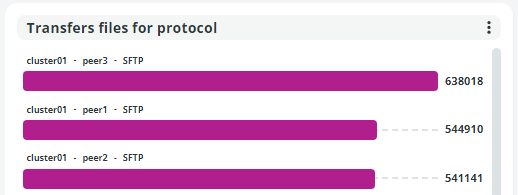Transfers Files for protocol
The Transfers Files for protocol card shows the number of files transferred in each protocol.
Refer to the Adding Cards page for detailed steps.

The graph shows all clusters, peers, and protocols, together with the number of files transferred.
If you move the mouse over the bar, the tooltips with the number of files in error and success status are displayed.

Clicking on the single chip opens the Transfers window, which lists all the files of the selected group. The Transfers window is equipped with a toolbar to easily navigate through results. Columns can be shown or hidden by clicking the  icon on the top right corner. Columns cannot be sorted but the list can be exported in CSV format by clicking the EXPORT button on the top left corner of the window.
icon on the top right corner. Columns cannot be sorted but the list can be exported in CSV format by clicking the EXPORT button on the top left corner of the window.
Clicking the 3 dots button in the upper right corner of the card, the following options will appear:
- Settings: Define if results must be grouped by cluster, by peer, or must not be grouped. Note that by default these options are enabled. To change the display, set the Group by cluster and/or Group by peer options to OFF and click the APPLY button.
When disabled, the graph will display only protocols and the number of files. - Filter: Filter the data displayed on the card according to the following criteria:
- From - To: Select the time range in which to collect data. Click the APPLY button to confirm each date selected.
- Filename: Enter the name of the file transferred. The specified string will be searched in all filenames, i.e. writing march will return all filenames that contain march anywhere in the filename. The graph will list all protocols containing the filename or string entered, showing both the protocol name and the size of the bytes.
- Protocol: Select one protocol choosing among those listed. Once the filter is applied, the card will display only the results that match the selected criterion and a funnel icon will appear to indicate that the results are a subset of the total.
- Peer: Enter the name of the peer for which you want to know the number of files transferred.
- Cluster: Enter the name of the cluster for which you want to know the number of files transferred.
- Outcome: select SUCCESS, FAILURE or ERROR. Once the filter is applied, the card will display only the results that match the selected criterion.
- Source: If you want to know the number of files from a specific source, enter the name of the source in this field.
- Destination: If you want to know the number of files that have arrived at a specific destination, enter the name of the destination in the field.
- Source Queue: If you want to know the number of files started from a specific source queue, enter its name in this field.
- Destination Queue: If you want to know the number of files of a specific destination queue, enter the name of the queue in the field.
In the Filters window, to remove an option, click the red X.
The RESET button restores default settings.
In the Transfers Files for protocol card, when a filter is applied, a funnel icon appears in the upper right corner to indicate that the results shown are a subset of the total. Clicking the funnel icon, all applied filters will be listed. To open the Filters window and edit them directly, click the pencil icon.Tip:
In the Filters window, editable fields (e.g. Filename, Source, Destination, etc.) do not accept wildcard characters. These fields are case insensitive.
You can create as many cards as you need to meet the number of criteria you require. For example, you can create a card with the number of files for all protocols and another only for files in ERROR; or a card with all files to all destinations and another with files arrived to a specific destination. And so on.
- Color: Select a different color for the external border of the card. Click the RESET button to restore default colors.
- Remove: Select the option to remove the card. Note that the card will be removed without any further prompting.
Updated 3 months ago
